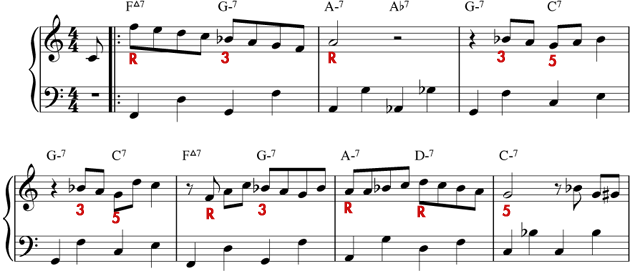Guide To Quickly Arranging Lead Sheets

In this month's article, I am going to talk about different techniques you can use to quickly create an arrangement from a lead sheet. Lead sheets, sometimes referred to "Lead Lines" are when you are presented with only the chords and melody of a song. If you know how to create an arrangement using lead sheets, you have thousands of songs at your fingertips.
Now, you probably already know that in order to create an arrangement from a lead sheet, you must know your chords. Knowing your chords on the piano is an important skill for all musicians. However, instead of just playing block chords, we will be using chord shells to create a more interesting arrangement.
Video Lesson:
Step 1 - Finding & Playing The Roots
The first step in preparing our arrangement is to start with only the roots of the chords. The Root of the chord is the letter to the far left of the chord symbol. Let me explain....
Every chord symbol has (2) parts: 1) the root and 2) the symbol. Our new Holiday Quick Start lesson uses chords from the song Baby It's Cold Outside. Here are the first four chords for the song: FΔ7, G-7, A-7 and Ab7. The roots of these chords would be: F, G, A and A flat. On the Ab7 chord, remember, it is NOT A...flat 7. It is A flat...7
Let's take a look at the first four measures of the song to see how we can apply this technique. The melody has been changed a bit.
By playing only the roots of the chord, we are creating a simple arrangement that will work, but it is not very full. Let's change that by adding our 7ths and thirds.
Step 2 - Root-7, Root-3 Chords
The third and seventh notes of our chord are important because they help define the type of chord that we are playing. Here is an example, if we play only C and G in our left hand, is this a Major 7th, minor 7th or Dominant 7th chord? Well...we don't know, do we? However, if you play C and Bb in the left hand, now you have defined this chord as either a minor 7th chord or a dominant. This is what we are doing in step 2.
In the example below I've added the Root and 7th or Root and 3rd in the left hand. We can use the shorthand R7 and R3 to label the chords. What about the R6 you ask? Well, when playing a Major 7th chord, it is often advantageous to play a 6th instead of a Major 7th because the Major 7th sounds tense if the melody note is the root of the chord. In this example the melody is an A, G and C but the original has an F in it so I replaced the 7th with the 6th.
Step 3 - Adding Motion
Now that you can play the roots, R7 or R3 in the left-hand, it sounds nice to break up these chords to create more motion. In this example, we have taken the same chords in step 2 but now we are breaking them up into quarter notes. You can get fancier by altering the rhythm of the left-hand, but it sounds nice to just "keep it simple." Remember, we are trying to get a 'quick arrangement' happening here, so simple is good!
Step 4 -Improvisation
The last step is to create a simple improvisation. I go into this in much more detail in the lesson, but here are some important points:
- Look for diatonic chords - all of the chords (except 2) in the example below are diatonic. This means that the notes of the chord are all found within the F Major scale
- Diatonic chords mean you can use your Major scale for improvisation
- Pay attention to target notes. I've circled how the note of the improvisation works with the chord. You'll see in the first measure the improv hits the Root of FΔ7, then the 3rd of G-7, then the root of A-7 and so on...



